
Sunday, January 20, 2019
Wednesday, November 28, 2018
Idlis Steamed In Screw Pine Leaves (Moode)
Idlis Steamed In Screw Pine Leaves (Moode)
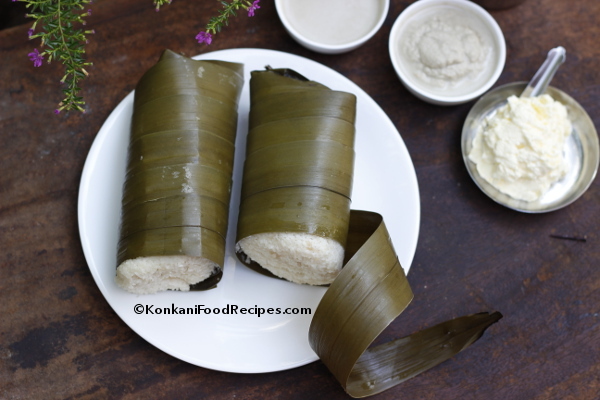 In the beautiful land of Udupi, Mangalore, plain idlis are made special and fragrant by steaming idli batter in jackfruit leaves, banana leaves, pandan/screw pine leaves, turmeric leaves, teak leaves, Macaranga peltata leaves (recipe will be up on the blog soon).
In the beautiful land of Udupi, Mangalore, plain idlis are made special and fragrant by steaming idli batter in jackfruit leaves, banana leaves, pandan/screw pine leaves, turmeric leaves, teak leaves, Macaranga peltata leaves (recipe will be up on the blog soon).Moode are idlis wrapped up like a mystery in screw pine leaves! A delicacy from Udupi, Mangalore region. The screw pine leaves/pandan leaves add a distinct taste and aroma to idlis and make them special, unique and delicious.
Screw pine leaves are weaved into cylindrical moulds and are used to steam idli batter. They make cylindrical idlis, which are called as ‘moode’ in Kannada/Tulu. They are made during festivals, a must for Krishnajanmastami festival and are served as breakfast during special occasions and celebrations. It also shows up on tables of most Udupi, Mangalorean homes as breakfast every once in a while. People from Udupi and Mangalore have a flair for these cylindrical idlis.
Moode are versatile, they are traditionally had with butter/ghee/coconut oil on top and with coconut chutney's, chicken curries, sprouted green gram coconut based curry, a sweet-sour-spicy pineapple curry etc.
The art lies in making these moulds, which is slowly dying. You then steam your normal idli batter in these cylindrical moulds. Steaming is when the magic happens. The screw pine/pandan leaves impart an amazing taste and aroma to the idlis. And that’s when the heavenly smell of steaming moode, fills up your home.
These days people buy moode moulds from roadside vendors in Udupi, Mangalore as making them involves a lot of work. Thanks to our lovely neighbours, the Madhyasta family, who’s mastered the art of making moode moulds, we got some beautiful moulds. Here’s a video of Geetha Madhyasta, our neighbour, teaching me how to weave a moode.
Ole means leaves in Kannada, mundakka in Kannada is the local name of pandan/screw pine plant, hence moode are also called as mundakana ole, oli kadubu in Kannada in Udupi, they are also called as voli moode in Tulu, mundanoli khotto in Konkani.
Traditionally, Pandanus unipapilatus, the screw pine variety having vicious thorns on the spines and sides of the leaves are used to make moode (the cylindrical moulds). The thorns are neatly scaled, the leaves are then withered in an open flame on the ground (these days on the cooking stove) to remove moisture from the leaf. This makes the leaves less brittle and prevent tearing of the leaves. And thus prevents oozing out of the batter from the moulds, later on while steaming. The withered leaves are then weaved into cylindrical moulds. The screw pine leaves are thick enough to be split into 2 and be used to make moode moulds. Each screw pine leaves are long enough to make 2-3 moode's too.
Natives of Udupi, Mangalore have found a variety of pandan without thorns. These leaves help save time and effort involved in removing the thorns off the screw pine leaves traditionally used (Pandanus unipapilatus). This variety of pandan is called as mundaka in Kannada and also grows easily in backyards unlike the screw pine variety with thorns (Pandanus unipapilatus), which usually grows along side beaches, river banks, ponds of coastal areas. Sorry couldn't find the species the plant belongs to, as the genus Pandanus has over 750 species of plants, commonly called as screw palms, screw pine, pandan. Leaves of these mundaka plants look similar to any other variety of screw pine leaves, impart similar taste and smell to idlis. The leaves in the images below and the leaves used in the video above are that of mundakka, the variety of pandan without thorns widely available in Udupi. The plant, leaves look like these:

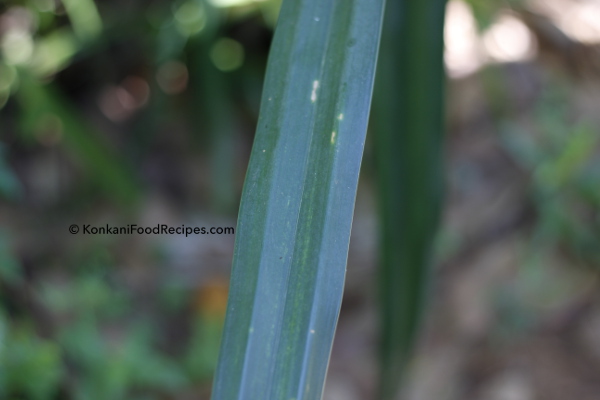
These super long leaves (which go upto 60cm) are withered on a cooking stove or in an open flame on the ground and then the leaves are rolled tightly one after the other to keep the long leaves intact in shape untill they are used. These circular rolls made are called as chandrike in Kannada.
If the leaves aren't withered with care then they smell completely of smoke and they may not be very pleasant to eat.

The withered leaves tend to change in colour with time. They brown, so use them while they are fresh for an amazing smell and taste.
Moulds ready to steam idlis in:


My neighbour uses the thorns of Catunaregam spinosa, kaarekaayi gida, maggaare in Kannada, to make these moulds. You can also use dried coconut leaves petioles, dried bamboo sticks to make these moulds.

Each moode can hold a lot of idli batter due to it's elongated shape and 2 moodes can fill you up. :-) Moode filled with idli batter, on the steamer:

Here’s how they look after they are steamed:

The colour of the leaves change on steaming:


Before you serve them, remove all the thorns used to keep the moode moulds intact. Peel open the moode slowly as shown below:





Ingredients:
Ingredients:
- 3/4 cup split black lentil (urad dal)
- 1.5 cups of rice semolina (idli rava, rice rava)
- Salt to taste
- 5-6 moode moulds
Prep Time: 60 minutes, overnight fermentation
Cooking time: 30 minutes
Preparation Method:
- Grind the batter for these idlis on the previous night of preparation.
- And to make a batter, soak urad dal for a minimum of 30 minutes. Wash them well and drain all the water.
- Grind them using as little water as possible into a smooth paste. I suggest using a wet grinder over a blender, for a super smooth batter.
- Transfer the ground batter into a big vessel. Add in rice semolina, salt and mix well. The batter tends to rise on fermentation so use a bigger vessel.
- We need a semi-thick batter and not a very thick batter. The batter should fall off the ladle easily. So, add a little water if required. Be careful not to add excess.
- Keep the batter closed aside and allow it to ferment overnight for a minimum of 7-8 hours on hot days and 10-12 hours during winter. If you live in a cold region look for tips to ferment the batter below.
- Just before you steam these idlis in the morning, give the batter a nice mix as the semolina would have settled down at the bottom of the vessel.
- Get your steamer going and once the water is rolling hot start filling the batter into the screw pine moulds.
- First keep the screw pine moulds into the steamer lined up next to one another.
- Then pour fermented batter into the moulds upto 3/4th of the mould, as the fermented batter tends to rise and fill up the mould. If not they fall out of the mould.
- If your moulds aren't standing straight once they are filled, then place them inside idli moulds/ramekins to prevent them from toppling over.
- Steam them for 30 minutes on a medium flame.
- After steaming, open the lid and put it back on with a little space for the steam to escape. Don't close it fully, to prevent steam from trickling onto the idlis.
- Serve steaming hot moode by peeling the leaves after 5 minutes of steaming. They otherwise tend to break into pieces if you try to peel them soon after steaming.
- Before you serve them, remove all the thorns used to keep the moode moulds intact. Peel open the moode slowly as shown above.
Serve steaming hot mudde with butter/ghee/coconut oil on top and with a spicy coconut chutney or chicken curry or sprouted green gram coconut based curry or a sweet-sour-spicy pineapple curry etc.
Note on fermenting the idli batter if you live in a cold region:
Fermentation needs warm temperatures. So, in summer the batter ferments very well and doubles or triples in it's quantity within a few hours. With drop in temperatures you would have to ferment them for longer.
But in cold places, the batter has to be kept in a warm place for it to ferment. If your oven has light, then turn on the light for a few hours with the batter in the oven. Once the oven is warm, turn off the light and let the batter undergo fermentation.
If your oven does not have a light, then preheat the oven to warm, turn off the oven. Then keep the batter in the oven to ferment.
You would have to experiment and keep a watch to get the right amount of fermented batter depending on the temperature in your place.
More info on Pandan:
Mundaka isn't the flavourful pandan leaf, Pandanus amaryllifolius variety widely used to flavour rice, sweet and savoury dishes. (Called as sannakki in Kannada.) However, the leaves look pretty similar, the only difference being, the mundakka used to make the above moulds have a thick, broad, dark green, leathery textured, long leaves unlike the flavourful, thin, not so long, pandan leaves below: Pandanus amaryllifolius leaf, sannakki leaf:

Pandanus amaryllifolius plant, sannakki plant:

More Info on Pandanus amaryllifolius: http://theepicentre.com/spice/pandan-leaf/, http://www.cooksinfo.com/screw-pine-leaves.
They are also different from the fragrant screw pine - Pandanus odorifer - http://www.itslife.in/gardening/wild-plant-and-flowers/kewda-tree
Find more Konkani cuisine, Udupi, Mangalorean breakfast recipes here.
Tags: kedige leaves, screw pine leaves, pandan leaves, moode, mooday, kadubu, kottige, mundakana ole kadubu, oli kadubu, Idlis steamed in screw pine leaves, Udupi cuisine, Mangalorean food
Categories
Recent Recipes
Pan Fried Chayote Squash (Chow chow/Seemebadnekai Phodi Recipe)
Spinach in Coconut Gravy (Konkani Style Palak Ambat Recipe)
Chayote Squash Stir Fry Recipe (Chow chow/Seemebadnekai Palya/Upkari)
Sprouted Whole Wheat Salad Recipe
Lady's Finger/Okra Stir Fry Recipe (Benda Upkari)
Simple Konkani Breakfast From My Granny’s Kitchen - Poha Recipe (Phovu Phaan Recipe)
Konkani Style Field Marrow Stir Fry (Magge Upakari Recipe)
Pan Fried Bananas, Konkani Style (Kele Phodi Recipe)
Snake Gourd Stir Fry Recipe (Podale Upakari in Konkani)
Snake Gourd Salad Recipe
Monday, November 5, 2018
The Story Behind One Of Mumbai’s Oldest Standing Eatery That Belongs To A Yazidi Family: Yazdani Restaurant & Bakery

Parvez
Irani could be any old man sitting on the counter of a restaurant
collecting cash. He’s so much trained in his trade that the best of
corporate employees could be put to shame with his no-nonsense demeanour
and a poker face determined to get work done well. He can be quite
intimidating at first, but it’s his eyes that say a different story.
Literally, a different story, because his eyes have a sharp hint of grey
in them, a trait of the Yazidi community from the West Asia.

Parvez Irani, the owner of Yazdani Bakery
In another part of the world, Parvez’s community is suffering genocide at the hands of ISIS. None of that seems to remotely affect him, as the now 76-Year-Old Parvez has been born and brought up in Mumbai and calls himself a true patriot (Because he knows the true meaning of the 24 spokes on the Indian flag – he thinks it has not much to do with King Ashoka, but that you’re supposed to do one good deed per hour). He knows more about the Indian flag than anyone of my generation will ever know. He impatiently rings the bell on his counter of the Yazdani Bakery to call on the men who are waiting for the tables of the restaurant and bakery.
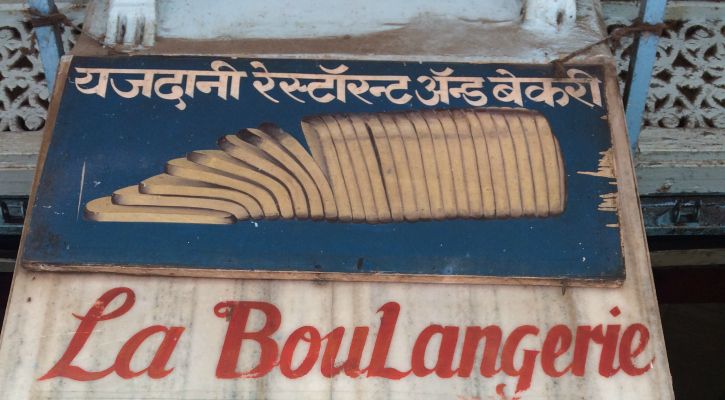
The old style posters still stand at the entrance
Someone once told me that Parsi and Irani bakeries are different, and asked Parvez the same to clear my doubt. Parvez immediately rubbished it and said, “The only difference between us is that the Parsis came 1200 years ago and we came about a hundred. But we’re the same people and every ritual and practice we follow is exactly the same,” he shares with us.
Don't Miss
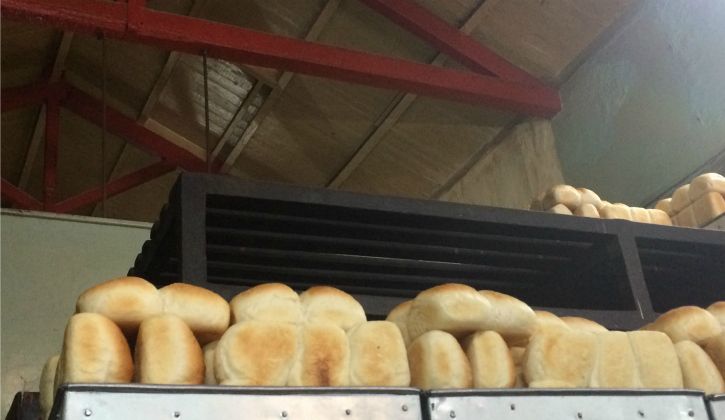
buns are the decor in this old structure
Travelling through the time
Entering
Yazdani bakery is like stepping into a time warp. You’re immediately
transported into what would look like the 1950s, exactly when the bakery
was established. The narrow lane near the Horniman Circle, Fort was
really busy on the Tuesday afternoon we visited.
The
lane itself mirrors the good ol’ Bombay, but swanky Mercs and posh BMWs
passing through the lane are major old-world-charm killers. The bakery,
on the other hand, has a wall full of posters and advertisements from
the yesteryears, with grandfather clocks hung on two walls. Even the
menus displayed outside and inside are written with a chalk on a wooden
blackboard.

wall with advertisements and posters from the 50s
Parvez tells us that when Babri Masjid was demolished, leading to riots in 1992 in Mumbai, Parvez recalls that Yazdani was the only open bakery in that area, providing food to those stranded and homeless.
“No police or politician made any attempt to come and shut us down. And this support from the people still stands with us,” he tells us proudly.
This is evident when we look around the place that is so sturdy and teeming with regulars and the frequent knells of ‘Bun-Maska-Chai” booming through the room.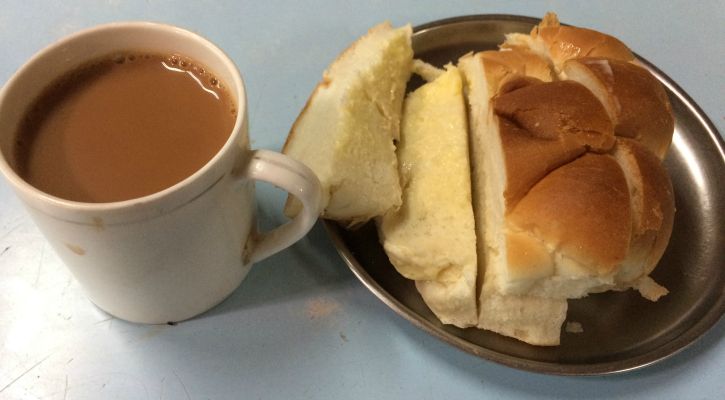
the classic bun maska and tea at Yazdani
The baking style is obviously old – done manually with little to no help of machines. As the bakers stand in the farthermost section of the bakery spraying flour across the gigantic table and kneading kilos of dough with the finesse that would give quite a competition to their French counterparts. And they seem to be in the flow – happy, content, and in almost movements so synchronized they could be called choreographed.
Something old, Something new
The
first Starbucks café in Mumbai had opened in Horniman circle’s fancy
Elphinstone building in 2012, and lives up to the hype of its name – a
comfortable, classy café with a perpetual coffee aroma for the company.
It’s air conditioned, unlike Yazdani bakery which is barely fifty meters
away from the international franchise outlet.

stark contrast between the two cafes near horniman circle
And
yet, Yazdani has a large and loyal fan following. May be it’s the
feeling of having time travelled into a classic Irani restaurant in
Mumbai, or simply the dollops of maska in the bun-maska they offer,
Yazdani is full of character – just like your favourite old book lying
rugged on your shelf.
Parvez’s father had set
up Yazdani Bakery & Restaurant in 1950, which Parvez joined in 1959.
“People used to be so large hearted back then. My father used to give
away food to the poor just like that,” Parvez gestures ‘giving away’
with his skinny, wrinkled hands.
“Sometimes,
people would not have enough money and even then my father would let it
go. The Nehru government had hiked the rates of maida and there was not
much of a scope for profit. But still, my father said that the
difference of one naya paisa should go into the stomach of the
customer and not our pockets. Since then it became a norm to give the
leftovers to the poor. This, was until we could afford a new fridge,”
Parvez laughs and points at one standing at the corner of the
restaurant.

Parvez Irani posing with a friend outside his bakery
Parvez’s family has been into baking for a long time. He tells us that his ancestors were bakers in Iran and were bakers after they came to India. His grandfather had opened a bakery somewhere in Mumbai, where his grandmother used to make bread while his grandfather sold it. Yazdani was later set up in 1950 after his father decided to let go of a partnership business and set up his own.
British architecture under the blue sky
The
structure of this bakery with its sky blue exterior and red painted
roof stands alone among the elegantly carved British architecture on one
side and neat commercial buildings on the other. And it’s surprisingly
bigger on the inside – huge table to knead dough and large ovens to
bake, and still, so much of room left that one could get their dance
rehearsals done while the bread baked in the ovens. Yazdani bakery still
uses an old style bread cutter, which is quite fascinating but
efficient nonetheless. Stacks of hot dog buns are perhaps the only
embellishment in the otherwise faded blue interiors and high vaulted
ceiling above.
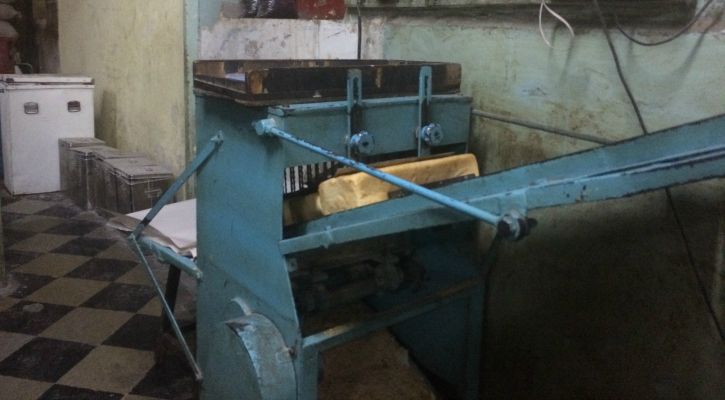
the bread cutter used here is rare and won't be seen elsewhere
It looks like the Irani bakeries of Mumbai are living on borrowed time from three different generations. They serve the same dishes they did back then, and have people loving it, but are slowly being swamped by a different generation who loves polished wooden floors and a crowd that loves imitating an accent.
The speciality of
the bakery – bread pudding usually gets only hours after it is made. So
we sort of made ends meet with an egg puff, bun maska and chai. There’s
a lot more they offer – the apple pie, carrot cake, fiery ginger
biscuits and muffins – all of which almost get over by the end of the
day.

the insides of this bakery are huge and spacious
Parvez’s son Tirandaz may be slightly less perky than his father, but still, has an interesting perspective regarding the death of the Irani café culture in the city. “The new cafés that are taking over the city are very fancy and have more facilities, but I wish that old places like these are retained and managed well. Our coming generations are so much in awe of the westernised world that they will voluntarily not take over the family business or manage the bakery. I would still wish that this bakery went on forever,” he tells us.

Tirandaz Irani, the next generation who will take the bakery ahead
Is the change good?
Places like the Yazdani bakery are rare. When nobody provided livelihoods to people, the bakeries and restaurants did. Less than a dozen people work in Yazdani, and have been for almost all their lives.Irani bakeries and cafes may look ordinary from the outside and may seem mundane to those who are ignorant to the beauty of the antiquated, but always have something fun to tell. Right from the exteriors to the people who visit it, Yazdani takes you on a trip to a less polished, raw and ragged Mumbai – the one that told tales of its initiation, survival and how it still stands undeterred and moves on but still retains its glamour.
Thursday, November 1, 2018
Jews From Cochin Bring Their Unique Indian Cuisine to Israeli Diners
On a moshav in southern Israel, the women behind Matamey Cochin keep alive the flavors of an ancient Jewish community
By Dana Kessler
October 23, 2013 • 12:00 AM

(Shy Shmuel; recipe photo below Hadasa Shani)
One of Israel’s well-known traditions is “the great trip to the
East” that young adults take after completing their army service—whether
it’s to “find themselves” in ashrams, lie on the beach in Goa,
or smoke weed all day far from their parents’ observing eyes. This
tradition is one of the reasons Israelis think they know all about India
(the other being the fact that Israelis think they know all about
everything). But many Israelis don’t know that Jews have a history in
India that dates back to antiquity.While there are different groups of Jews in India, living in different areas, the Cochin Jews of South India are the oldest, dating back to biblical times. These Jews, whom the Hindu Raja granted their own area in the southern Indian port city of Cochin (known today as Kochi) during the Middle Ages, lived peacefully in what is now part of the state of Kerala. Even though they never suffered persecution, most of them immigrated to Israel in the 1950s and early ’60s. The majority settled in moshavim around the country, while some moved to various cities. In the 1960s, there were between 2,000 and 3,000 Cochin Jews in Israel. Nowadays, there are very few Jews left in Cochin, while the community in Israel, which grew due to intermarriages, totals between 7,000 and 8,000 members.
One of the moshavim where most Cochin Israelis are situated is Nevatim, in the south of Israel. Nevatim used to be an agricultural settlement, but since the local agriculture died down in the 1980s, the moshav has been striving to revive its economy by turning it into a tourist attraction, based on the heritage of its Cochin Jews. Tourists, from Israel and abroad, visit Nevatim for its beautiful synagogue, cultural center, and museum, as well as for the traditional food cooked and served by the women of Matamey Cochin.
Matamey Cochin (“Cochin delicacies”) is a business operated by eight local women between the ages of 55 and 65 who host Cochin-style meals in their homes or in the local hospitality tent, for groups who make reservations. When the idea of hosting traditional meals in the moshav came up, the women of Nevatim turned to Smadar Kaplinsky, who develops small businesses for women in Israel. She helped them get their enterprise off the ground four years ago this month, and, with the assistance of Partnership 2000 and the Jewish Agency, the women of Nevatim started holding cooking workshops for Taglit-Birthright Israel and other youth groups, as well as hosting meals for visitors. In addition to providing traditional meals for groups from the United States and Canada a few times a year, they cater mainly to groups from Israel.
I traveled to the Negev recently to visit Nevatim, where I met Bat Zion Elias (the moshav’s tourism coordinator), Geula Nehemia, Rima Efrayim, and Miriam Elias—four of the leading ladies of Matamey Cochin. Sitting in Nehemia’s garden, which surrounds a small art gallery where she sells her ceramics and her husband’s iron art, the women told me about their heritage and culture.
Although it is a small community, Cochin Jews are not a homogeneous group. There are two separate communities: Malabari Jews (who were known in Cochin as Black Jews and probably arrived in India as traders in the time of King Solomon) and Paradesi Jews (a community of Sephardic Jews who arrived in Cochin in the 16th century, after the expulsion from Iberia, and are known as White Jews). Just as the Malabari Jews were the majority back in India, they are the majority in Israel, too. The Cochin Jews in Nevatim “belong to the Black Cochin Jews,” said Bat Zion Elias. “In India the two communities lived separately, and it’s the same in Israel. Recently the Indian ambassador initiated a convention of all Indian Jews in Israel and brought all of us together for the first time, but generally there is no connection between the groups.”
After urging me to crumble a curry leaf—fresh from the curry tree that grows in Nehemia’s garden—in order to smell its unique aroma, the women started bringing various traditional dishes to the table, most of which were prepared with curry leaves, which Cochinis call veplla. Many of them seemed like exotic versions of more familiar dishes, and not necessarily Indian ones. I sampled pastels—deep fried pastries similar to empanadas, filled with minced chicken breast, onions, cabbage, and spices, which probably originated from Spain or Portugal. The kadtela pastel I was served had the same filling, but with a different kind of dough, which reminded me of blintzes. Dosha, a pancake that brought to mind the Yemenite lahoh, was served with a traditional spicy and sour sauce called chamandi, made of ground almonds, coconut milk, curry leaves, and mustard seeds. Hubba—semolina dumplings filled with minced chicken breast, onions, cabbage, celery, and coriander—looked like the Cochin version of Iraqi kubbeh. The women were quick to confirm that many of these dishes did arrive in Cochin from faraway places and were adapted to suit the local produce.
“Our food isn’t like the Indian food you know,” explained Miriam Elias, who, like Bat Zion Elias, was born in Israel; Nehemia and Efrayim were born in India and came to Israel as children. “We use different spices. We stick to a few basic ones and don’t mix them up like the Indians do.” A cookbook called Spice & Kosher: Exotic Cuisine of the Cochin Jews, which was published in Canada a few months ago, claims that the three C’s—cardamom, cinnamon, and cumin—along with coconut, coriander, and pepper, dominate this exotic cuisine. If you ask the women of Matamey Cochin, they will tell you not to forget curry leaves, black mustard seeds, garlic, onions, ginger, and turmeric.
Not only does their cuisine differ from Indian food from other areas, it differs from Hindu cooking in Cochin, too. First of all, it is kosher and devoid of dairy products (the closest you get is coconut milk), and some dishes are strictly Jewish and don’t exist in the local Hindu menu at all. Many of the dishes serve a certain purpose and are aligned with holidays and specific dates. For instance, the Cochin papadam (which differs from the kind of papadum you get in Indian restaurants) is eaten before the Tisha B’Av fast and is served with various kinds of curry. “When we say ‘curry’ we mean something completely different than what you know as curry,” clarified Bat Zion Elias. “Curry for us isn’t a spice mixture or a hot dish. Our curries are a variety of cold salads made out of cooked vegetables, like tomatoes, onions, or eggplants, sort of like matbucha. The meal before Tisha B’Av, as well as the dishes served during mourning periods, are always vegetarian. We eat chicken or beef on happy occasions.”
In day-to-day life, the Jews of Cochin ate a lot of vegetable and rice dishes, as well as fish and chicken. They boast a large variety of breads—some baked, others steamed, deep-fried, or pan-fried—as well as many different savory snacks. “In India, we didn’t have refrigerators, so most of the food was made fresh and eaten on the spot,” explained Bat Zion Elias. “But we also have a large variety of wheat snacks that are dry and can be kept outside for a long time. Any big event starts with a toast in which we eat these snacks, before starting the actual meal.”
Apart from helping the local economy by establishing culinary tourism in their area, Matamey Cochin’s main objectives are preserving the Cochin Jews’ tradition as well as empowering local women. “Smadar Kaplinsky organized elderly women in different areas, women who had vast knowledge but never did anything with it outside of the home,” said Bat Zion Elias. “That’s what she did for us, too. When we started out we were 18 women and one man, now we are eight women. It’s hard work and many dropped out along the way. But now we have a strong and unified group.”
Nehemia admits that for many years she didn’t cook this kind of food at all, and the group opened her up to her own tradition: “My kids grew up on schnitzel and mashed potatoes, like all Israeli children. After we started this project I found out that my grown-up daughter does like Cochini food and is eager to learn how to cook it. It is important to us to teach the next generation how to make this food, otherwise our culinary tradition will disappear forever.” Bat Zion Elias agreed: “In Nevatim and other settlements in which we are the majority, like Aviezer, Ta’oz, or Mesilat Zion, our cooking tradition still exists. But in places where Cochin Jews live among other ethnic groups, and where the young generation intermarries, it is starting to die out.”
There used to be a restaurant called Cochin in Kfar Yuval, a moshav in the Galilee panhandle, but it doesn’t exist anymore. Nowadays it seems the only other place to eat Cochini food in Israel besides Nevatim is at a similar set-up in moshav Mesilat Zion, near Beit Shemesh. This is also called Matamey Cochin, although it has no connection to the women of Nevatim, and is privately owned. “My family and I host homemade Cochini meals in our backyard for about seven years, maybe more,” said Benny Aline, the owner of Matamey Cochin in Mesilat Zion. “We cater to groups of at least 10 people, and usually 20 to 30 people. We get internal tourism as well as tourists from abroad, who come here to taste something new and different.”
Both Aline and the women of Nevatim sometimes venture outside of their home turf to sell their food at various food events and festivals, but when striving to preserve a dying tradition, festivals, workshops, and group meals aren’t enough. In Israel only one Cochin cookbook has ever been published: Eti Gilad’s The Cochin Cuisine, which was published independently in 2007 and has long been out of print.
“My personal drive was to document and preserve the tradition of the Cochin Jews and its culinary aspects,” Gilad, head of the Institute for Gender Research at Achva College of Education, told me. When I asked her what is so special about Cochin cuisine and why it should be of any interest to the outside world, Gilad—who was born in Cochin and immigrated to Israel with her parents when she was 4 years old—talked about healthy kosher food, much of it suitable for vegetarians (it has some meat and fish, but a lot of it is based on fruit and vegetables). “One of the interesting things about Cochin cooking is the use of coconut, in all its variations,” Gilad told me. “I got a call from Mea Shearim telling me I saved them, because coconut milk is a great substitute for milk in kosher cooking. Another interesting thing is our use of onions. We brown large quantities of onions, and then cook vegetables or whatever it is we are cooking in the onion juice, instead of cooking in water. A lot of our dishes are cooked this way, and it gives them a very distinct and special flavor.”
Gilad grew up in Yesud HaMa’ala and resides in Rehovot, but of course she has visited Nevatim many times and eaten at Matamey Cochin. “The most striking thing about the experience of eating there was the freshness,” she marveled. “In India we didn’t have refrigerators and the food was prepared before each meal. Freshness is one of the main principles of our cuisine, and the women of Nevatim are very strict about that. When you eat food with spices that have been pulverized on the spot, and not bought at the supermarket and kept in the fridge, or when you eat freshly baked bread, you can taste the difference, and of course everything is much healthier. It requires a lot of work, but the women of Nevatim do it with tremendous love.”
***
Like this article? Sign up for our Daily Digest to get Tablet Magazine’s new content in your inbox each morning.
Monday, July 17, 2017
Here are some of the specific health benefits of those maestro mint leaves...
Irritable Bowel Syndrome – The use of peppermint oil in enteric-coated capsules has been found to be a safe and effective treatment for those suffering from abdominal pain and discomfort caused by Irritable Bowel Syndrome (10), (11). One study conducted in 2007 showed that an impressive 75 percent of subjects who consumed peppermint oil saw a greater than 50 percent reduction in their IBS symptoms score, compared to those who took a mere placebo (12). In fact, peppermint oil "may be the drug of first choice in IBS patients with non-serious constipation or diarrhea to alleviate general symptoms and to improve quality of life" (13). The beneficial effect also extends to kids. In one children's trial, approximately 75% of those taking peppermint oil experienced reduced IBS-associated pain within 2 weeks (14).
Functional dyspepsia – A study performed in 2000 found that when subjects suffering from dyspepsia took a daily infusion of peppermint and caraway seed oil, 67 percent of them reported a significant improvement in their symptoms (15).
Gastric ulcers – In certain animal studies, it has been demonstrated that menthol helps to protect the lining of the stomach against the harmful effects of ethanol and indomethacin, making it a useful means of preventing the formation of gastric ulcers associated with prolonged use of painkillers and alcohol (16).
Gastric Emptying Disorders – humble peppermint has also been shown to facilitate gastric emptying, indicating its usefulness for patients that have various gastrointestinal disorders (17).
Colonic spasm – Other scientific studies suggest peppermint oil may be a safe and effective alternative to the drug Buscopan given its capacity to reduce colonic spasms in barium enemas (18), (19).
Infantile Colic – Another study done in 2013 discovered peppermint is just as if not more effective at treating infantile colic as the synthetic chemical with which it is usually treated, simethicone (20).
Bottom Line: Mint leaves have the potential to treat a number of gastrointestinal disorders, including Irritable Bowel Syndrome, functional dyspepsia, gastric ulcers, gastric emptying disorders, colonic spasm, and infantile colic.
Did you know the aroma of mint by itself helps to activate the salivary glands along with the glands that excrete digestive enzymes, thus promoting smooth and proper digestion of food? (21) This is precisely why mint has for long been used in appetizers and as an ingredient in palate cleansers.
What’s more, peppermint apparently increases bile secretion and makes bile flow more efficiently - and may also promote healthier cholesterol levels (22). Mint in addition is a good relaxant, and the muscles in your digestive tract are one of the things it relaxes (23). Each of these factors help to speed up and ease the digestive process.
Meanwhile, for sufferers of indigestion, a calming cup of peppermint tea after meals may be just what your sick stomach needs to feel better (24). Mint contains menthol and methyl salicylate which both ease stomach spasms, and help your gut to settle down. Peppermint further functions as a carminative, which means it helps to relieve discomfort and pain from gas and bloating. Peppermint tea is a traditional home remedy for flatulence! (25)
Bottom Line: Consuming mint leaves prevents indigestion and keeps your gastrointestinal tract in good shape. It also prevents wind!
Bottom Line: The menthol in mint helps dispel the unwelcome sensation of nausea. Peppermint oil helps relieve chemotherapy-induced nausea.
Bottom Line: Mint, whether applied topically or ingested as a tea, provides you with much needed (and all-natural) relief from pain caused by headaches and migraines.
Mint oil is a natural antiseptic, which makes it useful for healing skin infections caused by cuts and insect bites. The cooling properties of mild mint will provide you with relief from the sensations of itchiness and irritation, at the same time as its anti-inflammatory attributes bring the swelling down.
Suffer from shingles? A study conducted back in 2002 found that applying peppermint oil topically to shingles resulted in a rapid improvement in patients' shingles-associated neuropathic pain symptoms; what is more, the effects lasted throughout the entire 2 months of follow-up treatment (33).
Finally, mint juice is also an effective skin cleanser. In addition to helping to eradicate pimples, it can also assist those with acne (34). In the same vein, mint juice can also be applied to heal and soothe burns (36).
Bottom Line: Mint leaves help soothe skin irritated and inflamed by rashes, reactions, burns and insect bites. Mint is a good anti-septic. Studies have found it is effective in reducing pain caused by shingles. Mint leaves can also help reduce pimples and acne.
Bottom Line: Mint leaves can be used to make an all-natural, eco-friendly insect repellent.
Bottom Line: Applying mint leaves topically promotes healthy hair growth and prevents hair thinning and baldness.
Bottom Line: Eating mint leaves will get you looking trim, taut and terrific!
Bottom Line: mint leaves promote better vision, whilst preventing cataracts and macular degeneration.
In particular, mint may have a special role to play in preventing prostate cancer. Preclinical research shows that peppermint contains a compound called menthol which apparently slows and inhibits the growth of prostate cancer (45), (46).
Peppermint also contains a phytonutrient called monoterpene, which has been shown to stop the growth of pancreatic, liver and breast cancers in animal studies (human research awaits!). In addition, peppermint has a compound known as perillyl alcohol, which may halt the development and spread of cancer (Michael T. Murray and Joseph E. Pizzorno, authors of "The Encyclopedia of Healing Foods"). Yet other enzymes found in mint may also help prevent and treat cancer (47).
Bottom Line: Mint leaves contain antioxidants and other compounds which may inhibit the growth of cancers. One study suggests the menthol in peppermint may retard the spread of prostate cancer.
Bottom Line: Mint leaves have been shown to be effective in addressing seasonal allergies like hay fever.
Mint is also a good relaxant, and has a cooling effect which can help soothe sore throats, noses and other respiratory airways, and relieve the irritation associated with chronic coughing (52). Actually, it is for this reason that many balms contain mint - and why they tend to have greater effectiveness (and are more eco-friendly!) than aerosol-based inhalers.
Bottom Line: Mint is a natural decongestant, relaxant and coolant, and thus helps soothe the symptoms of respiratory disorders like common cold and asthma. One study also found it may be effective in treating tuberculosis.
Another recent study exploring the link between mint and cognitive function, discovered that those who regularly ate mint-flavored chewing gum, had significantly improved memory and alertness compared to those who did not (55). For the students among you, you’ve now actually got a good reason for bringing that stick of chewing gum with you into the classroom every lesson!
Bottom Line: The stimulating properties of mint leaves extend to stimulating your brain, leading to enhanced memory, alertness and cognitive function.
Bottom Line: In the same vein as No. 13, mint leaves can help perk you up when you’re feeling tired and depressed.
Bottom Line: The copper in spearmint leaves helps improve the overall functioning of your nervous system.
Bottom Line: Mint leaves are also good for your immune system.
Bottom Line: The manganese in spearmint leaves helps keep your bones strong.
Bottom Line: Mint promotes good oral health, by killing off the bacteria that cause bad breath and dental cavities.
Bottom Line: consuming mint leaves prevents cell and DNA damage associated with exposure to radiation.
Bottom Line: Eating or drinking mint helps cure the hiccups.
Bottom Line: Mint leaves may save breastfeeding mothers from the painful, cracked nipples often associated with breastfeeding.
Bottom Line: the iron and folate in spearmint contributes to the formation of healthy red blood cells.
Bottom Line: Mint leaves may prevent conditions associated with female sterility, though more research is needed.
Make Mint A Part of Your Meals ...
There are obviously loads of ways you can reap the health benefits of this tantalising little herb, in fact you've probably tried a few already - whether it’s a comforting cup of herbal tea, or a hearty chicken salad spiced up with some chopped mint leaves. You can add mint leaves to home-brewed iced tea and lemonade, or work it into your next fruit salad. Whatever you do, remember that mint is a tender herb, with the leaves best used raw or added right at the end of cooking so as to preserve their delicate flavor and texture. When buying mint, also look for bright, unbruised leaves. Store it in plastic wrap in the refrigerator for up to a week at a time.
Here are some delicious recipes that incorporate mint, which allow you to get all the aforementioned health benefits while at the same time enjoying a variety of lip-smacking drinks, snacks and meals...
This recipe combines both. Blend coconut water, mint, pineapple, lime, avocado and robust kale and you're done. Add in some grated ginger to give it some extra 'zing'. Chock full of nutrients from the mint, kale and avocado, this POWER drink aptly has a brilliant green colour. The Green Mojito and Mint Smoothie is another one best served chilled; if you want to drink immediately throw in some ice cubes before blending.
Making mint a part of your diet lets you improve your health and at the same time adds some extra zing to your drinks, desserts and meals. Once you've had that first mouthful of mint, you'll wonder how you ever lived without it!
1. Mint Leaves Help Treat Gastrointestinal Disorders
Much of the existing research on the therapeutic properties of mint suggests that the herb may be particularly effective in treating gastrointestinal disorders, including:Irritable Bowel Syndrome – The use of peppermint oil in enteric-coated capsules has been found to be a safe and effective treatment for those suffering from abdominal pain and discomfort caused by Irritable Bowel Syndrome (10), (11). One study conducted in 2007 showed that an impressive 75 percent of subjects who consumed peppermint oil saw a greater than 50 percent reduction in their IBS symptoms score, compared to those who took a mere placebo (12). In fact, peppermint oil "may be the drug of first choice in IBS patients with non-serious constipation or diarrhea to alleviate general symptoms and to improve quality of life" (13). The beneficial effect also extends to kids. In one children's trial, approximately 75% of those taking peppermint oil experienced reduced IBS-associated pain within 2 weeks (14).
Functional dyspepsia – A study performed in 2000 found that when subjects suffering from dyspepsia took a daily infusion of peppermint and caraway seed oil, 67 percent of them reported a significant improvement in their symptoms (15).
Gastric ulcers – In certain animal studies, it has been demonstrated that menthol helps to protect the lining of the stomach against the harmful effects of ethanol and indomethacin, making it a useful means of preventing the formation of gastric ulcers associated with prolonged use of painkillers and alcohol (16).
Gastric Emptying Disorders – humble peppermint has also been shown to facilitate gastric emptying, indicating its usefulness for patients that have various gastrointestinal disorders (17).
Colonic spasm – Other scientific studies suggest peppermint oil may be a safe and effective alternative to the drug Buscopan given its capacity to reduce colonic spasms in barium enemas (18), (19).
Infantile Colic – Another study done in 2013 discovered peppermint is just as if not more effective at treating infantile colic as the synthetic chemical with which it is usually treated, simethicone (20).
Bottom Line: Mint leaves have the potential to treat a number of gastrointestinal disorders, including Irritable Bowel Syndrome, functional dyspepsia, gastric ulcers, gastric emptying disorders, colonic spasm, and infantile colic.
2. Mint Leaves Aid Digestion
In addition to ameliorating the effects of gastrointestinal disorders, marvellous mint also promotes orderly digestion, and soothes stomach muscles beset by indigestion and inflammation. Mint is a soothing herb that has been used through the millennia to assist with indigestion and upset tummies (Michael T. Murray and Joseph E. Pizzorno, authors of "The Encyclopedia of Healing Foods").Did you know the aroma of mint by itself helps to activate the salivary glands along with the glands that excrete digestive enzymes, thus promoting smooth and proper digestion of food? (21) This is precisely why mint has for long been used in appetizers and as an ingredient in palate cleansers.
What’s more, peppermint apparently increases bile secretion and makes bile flow more efficiently - and may also promote healthier cholesterol levels (22). Mint in addition is a good relaxant, and the muscles in your digestive tract are one of the things it relaxes (23). Each of these factors help to speed up and ease the digestive process.
Meanwhile, for sufferers of indigestion, a calming cup of peppermint tea after meals may be just what your sick stomach needs to feel better (24). Mint contains menthol and methyl salicylate which both ease stomach spasms, and help your gut to settle down. Peppermint further functions as a carminative, which means it helps to relieve discomfort and pain from gas and bloating. Peppermint tea is a traditional home remedy for flatulence! (25)
Bottom Line: Consuming mint leaves prevents indigestion and keeps your gastrointestinal tract in good shape. It also prevents wind!
3. Mint Leaves Relieve Nausea
The menthol oil derived from freshly crushed mint leaves can also help soothe nausea and motion sickness (that makes it a very useful thing to take onboard flights!). Again, the mere aroma is often enough to ease your symptoms (26). One study from 2013 showed peppermint oil achieved good results in alleviating chemotherapy-induced nausea, and what’s more at a much cheaper price compared to standard pharmaceutical-based treatments (27). Were you aware that lots of people keep mint-containing products or menthol oil on their person at all times precisely to ward off feelings of nausea should they arise?Bottom Line: The menthol in mint helps dispel the unwelcome sensation of nausea. Peppermint oil helps relieve chemotherapy-induced nausea.
4. Mint Leaves Provide You With Pain Relief From Headaches
In addition to relieving nausea, mint leaves double up as a natural alternative to aspirin in the event of headaches. For example, it is known that when mint oil, or balms whose base is comprised of mint, are rubbed topically on the nose and forehead, they give rapid relief from headaches and migraines (28). Whereas brazilian mint (scientific name Hyptis crenata) has been scientifically demonstrated to be just as effective at providing pain relief as synthetic aspirin-style drugs when consumed as a "tea" (31). Magical mint is an inherently soothing substance, and so naturally it helps to ameliorate the symptoms of inflammation and fever that frequently accompany these conditions (29). In fact, applying peppermint extract externally has been found to increase the pain threshold in humans (30).Bottom Line: Mint, whether applied topically or ingested as a tea, provides you with much needed (and all-natural) relief from pain caused by headaches and migraines.
5. Mint Leaves Help Soothe Irritated Skin
Because of its soothing properties, applying mint topically can also be an effective treatment for skin irritations and itchiness, such as those caused by rashes, reactions, and the like (32). Next time you have an unwelcome run-in with some poison ivy, try applying a wet rag soaked in peppermint tea, some cold mint tea bags, or a mixture of water and peppermint essential oil. The anti-pruritic properties of mint oil also come in handy in treating bites from insects including mosquitoes, honeybees, hornets, wasps, and gnats (34).Mint oil is a natural antiseptic, which makes it useful for healing skin infections caused by cuts and insect bites. The cooling properties of mild mint will provide you with relief from the sensations of itchiness and irritation, at the same time as its anti-inflammatory attributes bring the swelling down.
Suffer from shingles? A study conducted back in 2002 found that applying peppermint oil topically to shingles resulted in a rapid improvement in patients' shingles-associated neuropathic pain symptoms; what is more, the effects lasted throughout the entire 2 months of follow-up treatment (33).
Finally, mint juice is also an effective skin cleanser. In addition to helping to eradicate pimples, it can also assist those with acne (34). In the same vein, mint juice can also be applied to heal and soothe burns (36).
Bottom Line: Mint leaves help soothe skin irritated and inflamed by rashes, reactions, burns and insect bites. Mint is a good anti-septic. Studies have found it is effective in reducing pain caused by shingles. Mint leaves can also help reduce pimples and acne.
6. Mint Leaves Make An Excellent All-Natural Insect Repellant
One study on natural insect repellants discovered that applying Australian bush mint essential oil to the arms gave great results, preventing mosquitoes both from landing on the skin and from biting it (37). If you don't have a bottle of the essential oil, you can rub the leaves directly on the skin (though it probably won't be as effective). In fact, mint oil is already found frequently in insect repellent devices such as citronella candles, as the smell alone is sufficient to ward off the majority of insects (35).Bottom Line: Mint leaves can be used to make an all-natural, eco-friendly insect repellent.
7. Mint Leaves Promote Healthy Hair
A 2014 study showed that topically applying peppermint essential oil to the scalp positively affected the growth of new hair follicles (38). That's great news for those of you concerned about thinning hair or pattern baldness! Consider trying out an organic hair serum with mint and rosemary (39).Bottom Line: Applying mint leaves topically promotes healthy hair growth and prevents hair thinning and baldness.
8. Mint Leaves Promote Weight Loss
Yet another surprising health benefit of mighty mint, is that it can help you in your attempts to shed those burdensome kilos! Not only is it low in calories but, as we have seen, mint is a natural stimulant, and it dutifully stimulates those digestive enzymes that absorb nutrients from food into the bloodstream, and catabolize fat into energy that can be used by your body (40). The more mint leaves you eat, in other words, the more of your fat gets consumed and converted into fuel, instead of being stored as KGs in your body!Bottom Line: Eating mint leaves will get you looking trim, taut and terrific!
9. Mint Leaves Improve Your Eyesight
Spearmint and peppermint leaves both contain generous quantities of vitamin C and vitamin A, which are known to contribute to improved vision (41), These elements also protect our delicate orbs from damage caused by roaming free radicals, which in turn prevents the occurrence of eye diseases like cataracts and macular degeneration (42). Mint is rich in vitamin A, especially: a half-cup of peppermint leaves provides 23 percent of the daily vitamin A requirement for men, and 18 percent for women; meanwhile, the same amount of spearmint leaves contains 62 percent of the male and 79 percent of the female requirement (43).Bottom Line: mint leaves promote better vision, whilst preventing cataracts and macular degeneration.
10. Mint Leaves Have Anti-Cancer Properties
Here is another startling health benefit of this remarkable little herb: it prevents cancer! As we have seen, mint contains anti-oxidants, and science has repeatedly shown a connection between a diet rich fresh fruits and vegetables - which are packed full of antioxidants like vitamin C - and reduced likelihood of contracting various cancers (44).In particular, mint may have a special role to play in preventing prostate cancer. Preclinical research shows that peppermint contains a compound called menthol which apparently slows and inhibits the growth of prostate cancer (45), (46).
Peppermint also contains a phytonutrient called monoterpene, which has been shown to stop the growth of pancreatic, liver and breast cancers in animal studies (human research awaits!). In addition, peppermint has a compound known as perillyl alcohol, which may halt the development and spread of cancer (Michael T. Murray and Joseph E. Pizzorno, authors of "The Encyclopedia of Healing Foods"). Yet other enzymes found in mint may also help prevent and treat cancer (47).
Bottom Line: Mint leaves contain antioxidants and other compounds which may inhibit the growth of cancers. One study suggests the menthol in peppermint may retard the spread of prostate cancer.
11. Mint Leaves Are An Effective Anti-Allergen
Each year, legions of people worldwide are afflicted by allergies such as hay fever (scientific name rhinitis) during certain months. In a 2001 preclinical study on rats, mint leaf extracts were found to have inhibited release of the chemical histamine, which is known to exacerbate symptoms of allergic rhinitis and other seasonal allergies (48). Mint also contains an anti-inflammatory agent called rosmarinic acid which has been shown to be effective in relieving symptoms of seasonal allergy symptoms (49).Bottom Line: Mint leaves have been shown to be effective in addressing seasonal allergies like hay fever.
12. Mint Leaves Are Good For Your Respiratory System
Mint contains menthol, an excellent natural decongestant. Again it’s actually the aroma of the herb that’s responsible for breaking up phlegm and mucus in the lungs, bronchi, nose and throat, clearing up congestion and giving you relief from respiratory disorders associated with common cold and asthma (50). For example, a 2009 study found that inhaled essential oil of peppermint was able to alleviate inflammation resulting from tuberculous, with the authors of the study concluding: "This procedure may be used to prevent recurrences and exacerbation of pulmonary tuberculosis" (51).Mint is also a good relaxant, and has a cooling effect which can help soothe sore throats, noses and other respiratory airways, and relieve the irritation associated with chronic coughing (52). Actually, it is for this reason that many balms contain mint - and why they tend to have greater effectiveness (and are more eco-friendly!) than aerosol-based inhalers.
Bottom Line: Mint is a natural decongestant, relaxant and coolant, and thus helps soothe the symptoms of respiratory disorders like common cold and asthma. One study also found it may be effective in treating tuberculosis.
13. Mint Leaves Improve Your Memory
Here's yet another example of how the mere smell of mint can improve your health! A study from 2006 reports that aromatherapy using peppermint leaves enhances the memory and increases alertness (53), (54). You can try this yourself at home: simply add a few drops of peppermint essential oil to your next bath. Or: boil up some shredded mint leaves in water and let the scent waft throughout your home. Even if it doesn't improve your memory, it will still leave the house smelling clean and refreshed!Another recent study exploring the link between mint and cognitive function, discovered that those who regularly ate mint-flavored chewing gum, had significantly improved memory and alertness compared to those who did not (55). For the students among you, you’ve now actually got a good reason for bringing that stick of chewing gum with you into the classroom every lesson!
Bottom Line: The stimulating properties of mint leaves extend to stimulating your brain, leading to enhanced memory, alertness and cognitive function.
14. Mint Leaves Help You Fight Depression and Fatigue
As we have seen, mint is an excellent natural stimulant; the smell by itself can be sufficient to recharge the batteries and dust the cobwebs out of your brain (56). If you've been feeling depressed, anxious, or tired lately, then consuming some mint or its derivative oils might be just what the doctor ordered! (57) It can either be ingested, applied topically, or the vapor inhaled - all of those techniques can give you a quick and welcome energy boost! Or you can put a drop or two of menthol oil upon your pillow before going to bed, and let the mint work its magic upon your brain and body as you sleep (58).Bottom Line: In the same vein as No. 13, mint leaves can help perk you up when you’re feeling tired and depressed.
15. Mint Leaves Improve The Functioning Of Your Nervous System
Adding copper to your diet helps you make phospholipids - a certain fat needed for healthy nerve function - and improves overall brain cell communication. And guess what? Spearmint leaves are also a good source of copper. A half-cup serving offers 12 percent of the daily copper needs for men and women (59).Bottom Line: The copper in spearmint leaves helps improve the overall functioning of your nervous system.
16. Mint Leaves Help Support Your Immune System
As we have seen, mint contains vitamin A, one of the perks of which, so far as your body is concerned, is that it stimulates the creation and improves the functioning of white blood cells, the foundation of your immune system (60). One recent study found that consuming peppermint helped to inhibit the activity of acyclovir-resistant Herpes Simplex virus type 1 (61), (62).Bottom Line: Mint leaves are also good for your immune system.
17. Mint Leaves Strengthen Your Bones
Spearmint is also a rich source of manganese, which helps your body synthesize certain proteins required for the healing of wounds, and also helps your bones maintain their proper strength. A half-cup serving of spearmint leaves provides 28 percent and 22 percent of the daily manganese requirements for women and men, respectively (63).Bottom Line: The manganese in spearmint leaves helps keep your bones strong.
18. Mint Leaves Promote Good Oral Health
This is a long-known health benefit of magical mint. Because mint is a natural anti-microbial agent and breath freshener, it aids oral health and hygiene by preventing the growth of harmful bacteria inside the mouth (which makes your breath smell better!), whilst cleaning your tongue and whitening the teeth. In fact, this is the reason why people in the Middle Ages would rub mint leaves onto their gums and teeth! In the modern age, and for similar reasons, mint is a commonly-found element in toothpastes, flosses, mouthwashes, and the like. In fact, concentrated peppermint oil extract has been found to be superior to the mouthwash chemical chlorhexidine, in killing the germs that cause bad breath, along with the streptococcus driven biofilm that are associated with dental cavities (64), (65).Bottom Line: Mint promotes good oral health, by killing off the bacteria that cause bad breath and dental cavities.
19. Mint Leaves Prevent Cell Damage Caused by Radiation
Preclinical studies indicate that peppermint protects you against radiation-induced DNA damage and cell death (66), (67). Good news for those of you who work in or around radiology and imaging, or the nuclear industry!Bottom Line: consuming mint leaves prevents cell and DNA damage associated with exposure to radiation.
20. Mint Leaves Help To Halt Hiccups
Drinking a glass of mint water is an old-fashioned (but effective!) home remedy for curing hiccups (68). Simply infuse a few sprigs of mint in a glass of water and drink up. Alternatively, you can try chewing on the leaves themselves. The reason mint helps suppress those hiccups is because of the menthol in it, which is thought to be effective in easing the muscle spasms in your digestive tract (69).Bottom Line: Eating or drinking mint helps cure the hiccups.
21. Mint Leaves Prevent Breastfeeding Associated Nipple Pain and Damage
Here's one for the ladies. Despite the sublime phenomenon of a mother breastfeeding her newborn child, an unpleasant byproduct experienced by many women is pain and damage (cracks) to their nipples. A study published in 2007 found that drinking peppermint water may be effective in preventing nipple cracks and pain in first-time mothers who are breastfeeding (70).Bottom Line: Mint leaves may save breastfeeding mothers from the painful, cracked nipples often associated with breastfeeding.
22. Mint Leaves Prevent Anemia
As we've seen already, spearmint supplies your body with quite a few essential nutrients: two more to add to the list are iron and folate. Both of these are required for the formation of healthy red blood cells, so that a surfeit of either results in anemia. A half-cup serving of spearmint leaves contains contains 30 percent and 68 percent of the recommended daily intake of iron for women and men, respectively, along with 12 percent of our daily folate needs (71). This is another good reason for pregnant women to get some mint into their diet, as anemia is extremely common among expectant mothers, with negative effects for both parent and child.Bottom Line: the iron and folate in spearmint contributes to the formation of healthy red blood cells.
23. Mint Leaves May Reverse Female Sterility
Some research indicates that mint may be used to successfully treat sterility in females. Spearmint has been found to have significant antiandrogenic effects in subjects suffering polycystic ovarian syndrome (72), whilst also ameliorating the related condition of mild hirsutism, marked by excessive hair growth in females, and which is also associated with female sterility (73). But suffice to say, a great deal of further research must be done on the effects of mint on female sterility. In fact, some argue that due to the insecticidal and germicidal qualities of the herb, prolonged use may in fact facilitate female sterility, killing off a woman’s ova and lessening the chances of conception.Bottom Line: Mint leaves may prevent conditions associated with female sterility, though more research is needed.
Make Mint A Part of Your Meals ...
There are obviously loads of ways you can reap the health benefits of this tantalising little herb, in fact you've probably tried a few already - whether it’s a comforting cup of herbal tea, or a hearty chicken salad spiced up with some chopped mint leaves. You can add mint leaves to home-brewed iced tea and lemonade, or work it into your next fruit salad. Whatever you do, remember that mint is a tender herb, with the leaves best used raw or added right at the end of cooking so as to preserve their delicate flavor and texture. When buying mint, also look for bright, unbruised leaves. Store it in plastic wrap in the refrigerator for up to a week at a time.
Here are some delicious recipes that incorporate mint, which allow you to get all the aforementioned health benefits while at the same time enjoying a variety of lip-smacking drinks, snacks and meals...
1. Limeade with Mint
This invigorating (though non-alcoholic!) concoction makes a perfect beverage for a hot summer's day. The inclusion of mint adds a delicate though refreshing flavour to a decidedly tangy drink. All you need to do is combine lime juice with water and lime zest, then garnish with several sprigs of fresh mint, and presto! you’re done. Make sure to include the lime zest for extra tanginess. Here's how to get the best results: make a simple syrup from sugar, water and grated lime zest, bringing to the boil in a small saucepan until all the sugar is dissolved. Strain out the lime zest using a sieve. Serve chilled.2. Green Mojito (& Mint) Smoothie
Smoothies share with mint the trait of versatility: you can drink them at breakfast to help get the day off on the right foot, or they are just as welcome throughout the day, whether as a mid-afternoon pick-me-up, or as part of your post-workout recovery drink. A lot of modern blenders come with to-go cups, so you can toss your pre-blended smoothies into your bag as you head out the door in the morning.This recipe combines both. Blend coconut water, mint, pineapple, lime, avocado and robust kale and you're done. Add in some grated ginger to give it some extra 'zing'. Chock full of nutrients from the mint, kale and avocado, this POWER drink aptly has a brilliant green colour. The Green Mojito and Mint Smoothie is another one best served chilled; if you want to drink immediately throw in some ice cubes before blending.
3. Cucumber Salad With Mint and Feta
This cucumber salad with mint and feta makes a perfect side dish, or a refreshing mid-afternoon snack on a warm day. Spicy, refreshing mint enhances the cooling effect of fresh cucumber. Simply toss sliced cucumbers together with radishes, red onion and mint leaves. Sprinkle with a simple dressing made from vinegar, salt, pepper, and olive oil; then right before serving add feta cheese, crumbled.4. Greek Lamb Kebabs with Yoghurt and Lemon Mint Sauce
Get a double dose of mint magic by making your salad the entree to this dish of lamb kebabs. Dunk pieces of lamb in your very own, homemade marinade of olive oil, garlic and red wine vinegar. Once marinated, thread onto rosemary sprigs and grill on the barbeque. Serve with the equally delicious sauce made from Greek yoghurt, lemon juice, mint, parsley, oregano, garlic, capers and anchovy also mentioned in the recipe. Bon appetit!5. Basil Mint Pesto
This mint pesto recipe is easy to make and goes well as a topping with any number of savory dishes - chicken, pasta, you name it. Blend toasted walnuts with mint leaves, basil, sunflower seeds, lemon juice and garlic. Use it straight away or refrigerate in airtight containers for later. Make extra large batches and you'll have enough pesto for months to come! Its yet another way to make mint a regular part of your diet, thereby reaping those many mint health benefits.6. Mint Julep
This is another recipe for a minty drink, this one for those of you who like your grog! This mint julep makes for a feisty shot to enjoy with friends at your next cocktail party. Prepare an infusion of mint, dissolved caster sugar and water, then stir through Gentleman Jack whiskey. Serve chilled or topped with ice. You can actually save some of the mint and use it to make minted ice cubes, too. Toss them in a punch bowl and top with the whiskey concoction; garnish with lemon wedges, and serve.7. Mint Chocolate Chip Ice Cream
Here's some good news! There are many ways you can make mint a part of your desserts as well. This is one such recipe. This homemade mint chocolate chip ice cream leaves the store-bought varieties for dead! Whisk together milk, cream, eggs, vanilla, dissolved sugar and salt; add freshly bruised mint leaves and let them infuse the mixture. Strain out the mint, and whisk and cook the mixture again, until it forms a custard. Freeze in an ice cream maker, adding in dark chocolate (chopped into chunks and flakes) while you’re at it. Freeze again before serving. You’ll find that this ice-cream has a much more delicate, fragrant flavor than the ultra-sweet variety you buy in the store.8. After Dinner Chocolate Mints
You chocoholics will be in heaven with these after dinner chocolate mints! They make a simple yet oh so delicious dessert option. Plus they allow you to get some healthy mint in your diet AND contain far less sugar than most after dinner mint morsels. Simply take some fresh mint leaves and run them through a dish of melted chocolate until both sides are covered. Place on baking paper, or in the refrigerator, and allow them to set.9. Fresh Fruit With Mint Salad
Mint plays well with fruit too. Bring a touch of the tropics into your kitchen today with this fruit and mint salad recipe. Chop your trusty mint leaves into tiny pieces and toss together with sliced mangos, kiwis, oranges, strawberries and a banana for good measure. Stir through honey and the citrus juice from the oranges. Add mixed berries, and serve with cream. This dish gives you another dessert option incorporating mint; but you can also have it as a refreshing snack throughout the day. Make sure to invite your friends over to share: to get them through the door, photograph and put it on Snapchat, as this dish is a feast for the eyes alone!10. Mint Tea
This ultra-refreshing mint tea makes a comforting, herbal drink for the evenings. Simply infuse boiling water with tea, mint leaves and sugar. Strain, and serve with mint sprigs.11. Chocolate Mint Brownie Sauce
To round things out, we've got yet another chocolatey treat for those of you whose sweet tooth is insatiable: luscious homemade brownies topped with an equally homemade mint brownie sauce. For the brownies, beat together butter, eggs, caster sugar, chocolate sauce, vanilla, flour, and chocolate mixture. Spread the mixture into a pan and bake in the oven. Meanwhile, mix together the mint layer from icing sugar, melted butter and creme de menthe liqueur. Spread over the cooled brownies, then top with a layer of mixture of chocolate blended with melted butter. Enjoy!Summary
Marvellous mint is a truly versatile little herb. In addition to its many other uses - as a flavoring agent, in cosmetics, medicines, inhalers and breath fresheners - the leaves also provide many fantastic health benefits, ranging from curing indigestion to preventing cancer. And with its invigorating, spicy taste and aromatic fragrance, it will make a friendly presence in your kitchen too. It's super easy to grow in your own garden (or even in small pots on the windowsill), so head down to your local nursery and collect some seeds or seedlings; pick out a few different varieties and see which ones you like the most. Be warned though: mint grows very rapidly, so you could well end up with more than you know what to do with!Making mint a part of your diet lets you improve your health and at the same time adds some extra zing to your drinks, desserts and meals. Once you've had that first mouthful of mint, you'll wonder how you ever lived without it!
Monday, May 15, 2017
Eat Healthy-Calcium Rich Event.
=================================================================
why russia is using my blog on food for some other -nefarious????-activities?
russia is not interested in indian food
i believe they are using this blog for hacking/etc etc etc etc

why russia is using my blog on food for some other -nefarious????-activities?
russia is not interested in indian food
i believe they are using this blog for hacking/etc etc etc etc
Pageviews by Countries
| Entry | Pageviews |
|---|---|
Russia
|
42
|
France
|
7
|
India
|
1
|
Monday, May 1, 2017
Get A Delicious Thali Of Non-Veg Mallu Food For INR 80 At This ... - LBB
https://lbb.in/mumbai/kerala-lunch-home/
.I like jitapur food
Subscribe to:
Comments (Atom)






